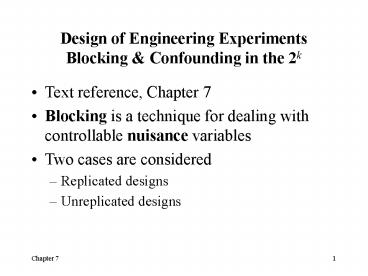Design of Engineering Experiments Blocking - PowerPoint PPT Presentation
Title:
Design of Engineering Experiments Blocking
Description:
Design of Engineering Experiments Blocking & Confounding in the 2k Text reference, Chapter 7 Blocking is a technique for dealing with controllable nuisance variables – PowerPoint PPT presentation
Number of Views:202
Avg rating:3.0/5.0
Title: Design of Engineering Experiments Blocking
1
Design of Engineering ExperimentsBlocking
Confounding in the 2k
- Text reference, Chapter 7
- Blocking is a technique for dealing with
controllable nuisance variables - Two cases are considered
- Replicated designs
- Unreplicated designs
2
(No Transcript)
3
Blocking a Replicated Design
- This is the same scenario discussed previously
(Chapter 5, Section 5.6) - If there are n replicates of the design, then
each replicate is a block - Each replicate is run in one of the blocks (time
periods, batches of raw material, etc.) - Runs within the block are randomized
4
Blocking a Replicated Design
Consider the example from Section 6-2 k 2
factors, n 3 replicates This is the usual
method for calculating a block sum of squares
5
ANOVA for the Blocked DesignPage 267
6
Confounding in Blocks
- Now consider the unreplicated case
- Clearly the previous discussion does not apply,
since there is only one replicate - To illustrate, consider the situation of Example
6.2, the resin plant experiment - This is a 24, n 1 replicate
7
Experiment from Example 6.2
Suppose only 8 runs can be made from one batch of
raw material
8
The Table of - Signs, Example 6-4
9
ABCD is Confounded with Blocks (Page 279)
Observations in block 1 are reduced by 20
unitsthis is the simulated block effect
10
Effect Estimates
11
The ANOVA
The ABCD interaction (or the block effect) is not
considered as part of the error term The reset of
the analysis is unchanged from the original
analysis
12
Another Illustration of the Importance of Blocking
Now the first eight runs (in run order) have
filtration rate reduced by 20 units
13
The interpretation is harder not as easy to
identify the large effects One important
interaction is not identified (AD) Failing to
block when we should have causes problems in
interpretation the result of an experiment and
can mask the presence of real factor effects
14
Confounding in Blocks
- More than two blocks (page 282)
- The two-level factorial can be confounded in 2,
4, 8, (2p, p gt 1) blocks - For four blocks, select two effects to confound,
automatically confounding a third effect - See example, page 282
- Choice of confounding schemes non-trivial see
Table 7.9, page 285 - Partial confounding (page 285)
15
General Advice About Blocking
- When in doubt, block
- Block out the nuisance variables you know about,
randomize as much as possible and rely on
randomization to help balance out unknown
nuisance effects - Measure the nuisance factors you know about but
cant control (ANCOVA) - It may be a good idea to conduct the experiment
in blocks even if there isn't an obvious nuisance
factor, just to protect against the loss of data
or situations where the complete experiment cant
be finished































